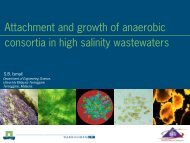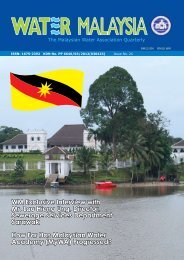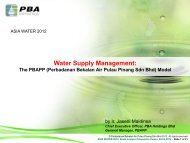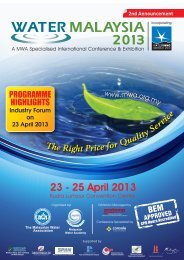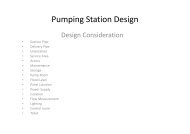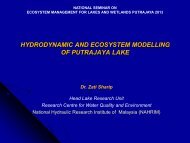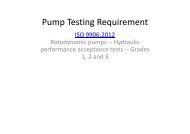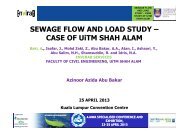Ir Dorai Narayana - Malaysian Water Association.
Ir Dorai Narayana - Malaysian Water Association.
Ir Dorai Narayana - Malaysian Water Association.
You also want an ePaper? Increase the reach of your titles
YUMPU automatically turns print PDFs into web optimized ePapers that Google loves.
When nature called ………..……. they just did it!
SEPTIC TANKSAll owner wants if for the sludge to beemptied and taken away. Safety,spills, safe treatment & disposal arenot his concern.When owner faces problems ofoverflow or other symptoms, herequests emptying.Owner is happy as long as he can usehis toilet. He may be unaware of theseptic tank. Effluent could very wellbe polluting the drains & rivers.
SEWERED SYSTEMRaw sewage outfallThey are generallynot interested whathappens after that.Users justwant a toiletthat worksAnd aneighbourhood freeof sewage overflowsCentralised sewage treatment
BenefitsEnvironmental benefitBENEFIT TOENVIRONMENTDIRECTBENEFIT TOUSERCentralised &Advanced systems:AddressEnvironmentOn sitesystemsPiped off-sitesystems: AddressPollution, communityconcernsSanitation: AddressPublic Health
In Malaysia:1994: Federalisation & Privatisation• Formed in 1995 , as a National Sewerage Concessionaire inMalaysia• Operate sewerage services over most of Peninsular Malaysia• Operation & Maintenance of sewage treatment plants (STPs) andsewer network•Septic tank desludging and sludge management
<strong>Malaysian</strong> context• Sanitation / sewerage by local authorities:– no direct charging for sewerage in most areas– Local Government Act allowed Sewerage Surcharge as part of propertycharges & “frontage” charges to cover part of CAPEX– Some local authorities charged “WC charge”– Desludging charges were minimal (estimated less that 1% desludged)• Privatisation Concession– Widespread resistance to direct charges– Yr 2000 : IWK acquired by Government– CAPEX responsibility assumed by Government– High percentage of refusal for desludging services (up to 70%)– Unwillingness to pay– Stagnant tariff– Customers perceive “no service”RevenueItemCollectionsRMX0.8 XCost ** Current costs. True costs may be up to double the revenue1.60 X
TIJUANA / SAN DIEGO,MEXICO/ USA• Tijuana River Valley is on theborder of Mexico, south of SanDiego, USA.• Tijuana River polluted bysewage flows from Tijuana,Mexico.• Pollution affected San Diego inthe United States.• US Congress authorized fundsto construct treatment facility inthe valley, to treat sewage fromTijuana
Wastewater Service as a Public vs. PrivateGoods• Private goods: benefits mainly to individuals and not to the public atlarge.• Public goods: benefits to the public at large;• Wastewater collection and treatment, has components of both publicand private good. Most countries recognize that wastewater treatmentprovides a substantial public good, and national budget funds subsidizeat least a part of local wastewater treatment.Lack of Demand for Wastewater ServicesUsers are reluctant to pay because they often differentiate betweenwaste collection and waste treatment, with waste collection seen asdirectly benefiting the system users. Treatment of the waste tends to beseen as benefiting downstream users and is often treated as a widerpublic good.
POLLUTERS PAY VS BENEFICIARIES PAY- SOME THOUGHTS ON SEWERAGE COSTS RECOVERY• Sanitation (addressing basic public health) evolving to Seweragemanagement (providing a better neighbourhood, safeguarding waterresources and preserving the environment)• Sewerage management deals with community goods. There hasalways been reluctance among people to pay for such services.• While these were Government services, costs were fully orsubstantially covered from general tax, with minimal direct charges onuser.• As private sector got involved, tendency is to look at “full costrecovery”, usually from the user.•The individual user is interested for the wastes to be removed out ofsight.•Sophisticated treatment of the wastewater to produce high qualityeffluent is necessary to protect the water resources and preserve theenvironment.•This benefits to the Nation – increased availability of water resourcesfor drinking, irrigation, aquaculture, tourism related activities and abetter environment contributing to the quality of life of the people.
FULL COST RECOVERY : FROM BENEFICIARIES- HOW DO THEY BENEFIT?UserCommunity<strong>Water</strong> resourcesEconomy• Wastes removed from premises• Clean neighborhood• Enhanced property value• Pleasant living environment• Unpolluted water for drinking andeconomic use• Tourism• Enhanced workforce productivity
World Bank’s Strategic Sanitation Approach:(i) preferences of users(ii) unbundling sanitation servicesHouseholds pay the bulk of the cost incurred in providingon-site facilities, including on-site sewer connectionsResidents of a locality collectively pay theadditional cost incurred in collecting wastesfrom individual houses and transportingthese to the boundary of the neighbourhoodResidents of a city collectively pay theadditional cost incurred in conveying ,treating & disposing the sewage.
UNITED STATES1970’s - USGovtConstructionGrantsProgram tostates forwastewatertreatmentplantconstruction.1981;Subsequenltyreduced to55%1987 : Clean<strong>Water</strong> Act(CWA) $18billionrevolving fundloans toStates.1975: Thefederal shareof projectcosts wasinitially 75%Upto 1985total amountof US $41billionallocated.
JAPANTrend in finance of sewerage constructiongeneral account budget :82,909 billion yenexpenditure for public works : 6,947 billion yennational expenses for sewerage : 696 billion yen6,0005,0004,878B ilion yen4,0003,0002,0002,4423,0653,1493,379 3,4092,9212,4332,152 2,1101,0000833 1,129 1,099 1,246 1,781 1,262 1,067 890 735 69690 91 92 93 94 95 96 97 98 99 00 01 02 03 04 05 06 07Total expenses forsewerage constructionSubsidizedexpensesNational expenses for sewerage ≒ Subsidized expenses ×50%
JAPAN
Setting of Appropriate Sustainable Sewerage Charges- Present IWK ModelCUSTOMER VIATARIFF+GOVERNMENTVIA SUBSIDY/GRANTFUNDING• Present tariff model poses a problem in relation to thebenefits to customers as against community• As investment & sophistication of sewerage assetsincreases, the community benefits more than the directcustomers• Hence increasing tariff to cover the cost ofinfrastructure improvements is seen as “not fair” to thedirect customersSEWERAGE FACILTIES& SERVICESO & M /CAPEXUSER COMMUNITY ENVIRONMENTBenefitsEnvironmentCummunityconcernsPublicHealthTariff + Tax forsustainabilityBenefits to Community,EnvironmentPossibility of highercost recovery fromtariff aloneBenefits to CustomersInvestment
EQUITABLE CHARGING FOR SEWERAGE• Consider perceived value to user - wastes to beremoved from premises, and out of sight• Beneficiaries from sophisticated sewerage systemsare the community, local environment andcommercial and industrial enterprises includingtourism• Appropriate that the user is only charged for thebenefit he derives, while the other beneficiariespay to make up the remaining costs throughdifferent tax mechanisms• Over time, as environmental awareness grows, alarger percentage of the costs may be borne bythe user• Resource recovery is a potential revenue sourcewhich may eventually enter the equation
Note: the views expressed in this paper are those of the authors and not necessarily ofIWK. It is hoped that these considerations can form the basis of sanitation / sewerage tariffsetting through policies in countries where appropriate.







